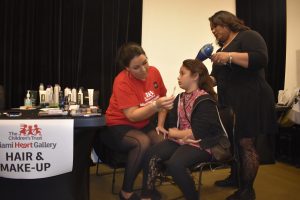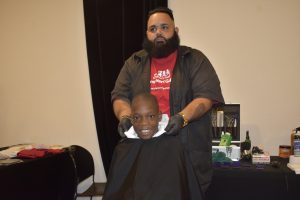By ISABELLA VACCARO
Jess Shuman knew immediately that the little girl she met tucked away in a downtown Miami caseworker’s facility would someday be her daughter. It was the day before Thanksgiving when the Shuman family first met Zoe, an eight-year-old foster child with long locks and a bulky cast hiding her dainty broken wrist.

At last year’s Miami Heart Gallery, which took place at History Miami Museum last March, Patience, one of many children growing up in the Florida foster care system, poses for photographers (Photo by Isabella Vaccaro).
“She was eight years old, but she was the size of a 5-year-old,” said Shuman. “The first meeting was an hour long, and she literally didn’t say a word the entire visit. So, it was an hour of Zoe just quietly staring at us and us trying to talk to her.”
At eight, Zoe was already considered an “older” foster child in the system back in 2014 when the Shumans first found her.
And the energetic youngster, who now thrives in school and plans on becoming a veterinarian one day, was actually classified as “special needs” because of her age.
According to Adoptuskids.org, the term “special needs” does not refer to a learning disability or mental disorder, but instead refers to “being an older child, having a particular racial or ethnic background, being part of a sibling group needing to be placed together as one unit” or just having a “medical condition.”
Of course, Shuman and her husband were scared. They were terrified. They had no idea what it was like for a child to be bounced from foster home to foster home – to never be certain where they might lie their head in a week, a month or a year.
In fact, according to a study done by the New England Journal of Medicineon trauma, foster children are five times more prone to suffer from post-traumatic stress disorder.
Adopting an older foster child is entirely different than adopting at birth – these older children and teens are forced to make and remake friends at each new school they attend every time they switch foster homes.
Click on the video above to view a video package about foster children in South Florida (by Isabella Vaccaro).
They are constantly gauging the personalities and emotions of their new foster families, wondering whether each new set of “parents” will like them enough to keep them around for a while or maybe even adopt them. It’s similar to a game – and a viciously stressful, taxing and sometimes even perilous one at that.
Shuman does not deny her fear throughout her individual adoption process, but instead has a message for those who are wary: “we didn’t know what we were going to get into with an older child, but there was no reason to be afraid. With love and care, there is nothing that you can’t work through with a family, so please do not be afraid of adopting a child from foster care.”
But Zoe’s fairy-tale ending is unfortunately just not the reality for so many foster children in Miami-Dade County. According to Our Kids of Miami-Dade/Monroe, Inc., the umbrella agency for all childcare services in Florida, there are more than 3,000 kids in Miami-Dade County’s foster care system in need of adoption.
“The reason why it’s harder for these kids to get adopted is because I think families believe that it’s easier to take care of a little one. The teenagers are the harder ones because they’ve been through some stuff,” said Sandra Camacho, media liaison for the Children’s Trust.
The idea of adopting a child during their tumultuous teen years alone may be a turn off for many families, but potential adoptive parents also have to worry about these kids’ criminal pasts. Daniel Wynne, a Miami-Dade County public school teacher and the juvenile justice liaison for his school district, admits that foster children are “over arrested and over-identified group because they are oftentimes involved in risky behavior.”
But is there too much scrutiny over this hapless demographic? Perhaps. According to a report released by the Florida Department of Juvenile Justice, from 2014 to 2015, only five percent of youth arrests were dually involved children, or children who, at the time, were placed out of their home by the Florida Department of Children and Families (DCF).
Movies, television and the mass media have twisted society’s view of foster children into a mutiny of unruly and destructive criminals. And although there is a band of law-breaking foster children, it is far smaller than people may think, and the crimes these kids are committing are “petty crime” like “drugs and stealing,” according to Wynne.

Foster child Matthew sits for a haircut at the 2018 Miami Heart Gallery, just minutes before he got to show off his backflip for the online multimedia exhibit (Photo by Isabella Vaccaro).
Wynne says that even after a child has committed a crime and is adjudicated to commitment – a supervision program lasting for six to 12 months depending on the severity of the child’s crime – there is still a high level of uncertainty in that child’s life.
“Typically, the kids who come out of commitment programs and returning to dependency situations, their home settings are completely up in the air,” said Wynne. “Oftentimes what will happen is the kids will go to the office of the guardian [the DCF worker in charge of that child’s security] and sleep on the couch in the office for the few days until they get a place to go. So, it’s really an onerous setting for the kids. They finished the program, they got out and then they don’t even have a place to go. They don’t know where they’re going to end up.”
It seems some foster children are susceptible to an avalanche of negative events in their lives. Trauma in their fosters home can lead them to commit frivolous crimes which can end them up sleeping on a couch in the DCF, essentially homeless.
It is not surprising that families would rather adopt a newborn baby to sculpt from scratch, without the psychological and sometimes physical baggage older kids often carry.
“There are many too many instances of physical and sexual abuse in foster settings, especially when they’re dealing with teenagers,” Wynne said. “I certainly think that that would create a lot of reasons why the kids would be hardened to dealing with adults, because it’s a really perilous situation for these kids. I don’t think anybody who doesn’t work with these kids on a regular basis has any sense of how perilous it is for them. It’s a terrible situation.”
But one man believes foster teens are inherently good, despite the bad rap many acquire during their years of foster care. William Presswood, a Homestead High School teacher and single father of five adopted sons, began his journey with the Florida childcare system over 10 years ago.
After deciding to foster one of his own students, Presswood was inspired to help as many children as he could, fostering more than 100 children over the years.
“Many of the kids we get have been told they are victims of circumstance or they’re not going to be able to do certain things,” said Presswood. “I think that’s been the greatest gift for me – that I can look at a child and see there’s so much more than the circumstances they came from, and that they have the potential to be so much more than other people maybe believe they can be, including themselves.”
Saunter into the front door of the Presswood’s home and it won’t be long before you run into a motley crew of brothers fighting each other for a sole Xbox controller. The boys, each hailing from a different family and much different foster care experiences, are bonded by the security of finally having a family and a home. Presswood gave them that.
“The moving around part – well, I would say the worst part about that is you really don’t know what you’re getting into,” said Lawrence Presswood, the oldest of the Presswood boys. “You don’t know where you’re going, you don’t know how far you’re going, you don’t know who you’re going to.”
And crossing his arms defensively, Lawrence’s brother, John, piped in “it’s always a surprise box.”
Lawrence admitted that while he was failing his classes during his tumultuous tour through foster care, his academics took an upturn after Presswood adopted him and helped him pursue “virtual school, night school” and “summer school” until he “eventually passed.”

Since last year’s gallery, Tamara, who sits for hair and makeup, is currently in the process of becoming adopted (Photo by Isabella Vaccaro).
And Presswood’s personal mission to help the youth of Miami-Dade County is one of the many positive outcomes of an organization called the Miami Heart Gallery.
Every year, the Children’s Trust holds an event dedicated to taking photos and videos of older, harder-to-place foster children and teens and posting them to an online gallery, in hopes that families will read about these kids and become inspired to adopt. Presswood adopted four of his five sons from these Heart Galleries.
“We have had a success rate over the past few years – over half of the children who have been featured on the Miami Heart Gallery have been adopted, and that’s a big difference,” said Camacho, the Children’s Trust media liaison and Heart Gallery coordinator.
“I’ve had teachers and people who have adopted that have mentioned the bond that they create with these preteens and the few years that they have with them,” Camacho continued. “And then they go onto college and they truly depend on these families for the rest of their lives.”
The stigma surrounding the adoption of “older” foster children could be just that – a stigma. In reality, the process can actually be rewarding and, oftentimes, life-changing for both the adoptive families and the foster child. Besides the material advantages these children are awarded, like free tuition to any Florida state university and Medicaid benefits, they receive something much more valuable – stable adult role-models and, finally, a source of love to rely on for the rest of their lives.
